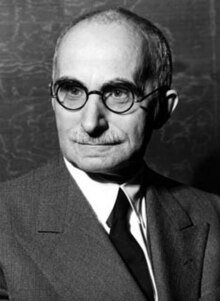Luigi Einaudi
|
His Excellency Luigi Einaudi OMRI |
|
|---|---|
 |
|
| 2nd President of Italy | |
|
In office 12 May 1948 – 11 May 1955 |
|
| Prime Minister |
Alcide De Gasperi Giuseppe Pella Amintore Fanfani Mario Scelba |
| Preceded by | Enrico De Nicola |
| Succeeded by | Giovanni Gronchi |
| Deputy Prime Minister of Italy | |
|
In office 1 June 1947 – 24 May 1948 |
|
| Prime Minister | Alcide De Gasperi |
| Preceded by | Position established |
| Succeeded by | Giovanni Porzio |
| Minister of the Budget | |
|
In office 6 June 1947 – 24 May 1948 |
|
| Prime Minister | Alcide De Gasperi |
| Preceded by | Position established |
| Succeeded by | Giuseppe Pella |
| Governor of the Bank of Italy | |
|
In office 5 January 1945 – 11 May 1948 |
|
| Preceded by | Vincenzo Azzolini |
| Succeeded by | Donato Menichella |
| Personal details | |
| Born |
24 March 1874 Carrù, Italy |
| Died | 30 October 1961 (aged 87) Rome, Italy |
| Nationality | Italian |
| Political party | Italian Liberal Party |
| Spouse(s) | Ida Pellegrini (m. 1903–61); his death (d.1968) |
| Children | Giulio |
| Alma mater | University of Turin |
| Profession | Teacher, economist |
| Religion | Roman Catholicism |
| Signature | |
Luigi Einaudi, OMRI (Italian: [luˈiːʤi eiˈnaːudi]; 24 March 1874 – 30 October 1961) was an Italian politician and economist. He served as the second President of the Italian Republic between 1948 and 1955.
Einaudi was born to Lorenzo and Placida Fracchia in Carrù, in the province of Cuneo, Piedmont. In Turin he attended Liceo classico Cavour and completed his university studies; in the same years he became acquainted with socialist ideas and collaborated with the magazine Critica sociale, directed by the socialist leader Filippo Turati. In 1895, after overcoming financial difficulties, he graduated in jurisprudence, and was later appointed as professor in the University of Turin, the Polytechnic University of Turin and the Bocconi University of Milan.
From the early 20th century Einaudi moved increasingly towards a more conservative stance. In 1919 he was named Senator of the Kingdom of Italy. He also worked as a journalist for important Italian newspapers such as La Stampa and Il Corriere della Sera, as well as being financial correspondent for The Economist. An anti-fascist, he stopped working for Italian newspapers from 1926, under the Fascist regime, resuming his professional relationship with the Corriere della Sera after the fall of the regime in 1943. After the Armistice (September 8, 1943) he fled to Switzerland, returning to Italy in 1944.
...
Wikipedia
